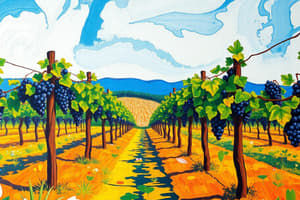Podcast
Questions and Answers
What is the primary function of lateral shoots on a vine?
What is the primary function of lateral shoots on a vine?
- To produce tendrils for support and attachment.
- To provide backup in case of a failed primary shoot. (correct)
- To produce the main grape bunches for harvest.
- To develop into the permanent wood structure of the vine.
Compound buds form and break open within the same growing season.
Compound buds form and break open within the same growing season.
False (B)
What function do tendrils serve for grape vines?
What function do tendrils serve for grape vines?
support
The stomata on leaves allow water to leave through the process of __________.
The stomata on leaves allow water to leave through the process of __________.
Which part of the grape contains the largest proportion of water and sugars?
Which part of the grape contains the largest proportion of water and sugars?
Permanent wood is less than one year old.
Permanent wood is less than one year old.
What is the term for shoots from the previous growing season that have not been pruned?
What is the term for shoots from the previous growing season that have not been pruned?
A cluster of flowers on a stem which becomes a bunch of grapes at fruit set is called an __________.
A cluster of flowers on a stem which becomes a bunch of grapes at fruit set is called an __________.
Which of the following factors does NOT influence the distribution of roots in a vine?
Which of the following factors does NOT influence the distribution of roots in a vine?
Clones will always have rootstock.
Clones will always have rootstock.
What is the name of the process of taking best cuttings from your own vineyard?
What is the name of the process of taking best cuttings from your own vineyard?
A hybrid vine results from parent species that are __________.
A hybrid vine results from parent species that are __________.
Which of the following is a disadvantage of using mass selection (sélection massale) for vine propagation?
Which of the following is a disadvantage of using mass selection (sélection massale) for vine propagation?
Pinot Noir Clone 521 has low yields of small grapes, making it suited to high quality red wine production.
Pinot Noir Clone 521 has low yields of small grapes, making it suited to high quality red wine production.
In layering, where does the cane begin to take root?
In layering, where does the cane begin to take root?
Sugars created in leaves are used for vine __________ and growth.
Sugars created in leaves are used for vine __________ and growth.
Match the following grape vine components with their characteristics or functions:
Match the following grape vine components with their characteristics or functions:
What are cordons?
What are cordons?
The grape varieties Pinot Noir, Meunier, Pinot Blanc and PinotGris are all mutations of the grape variety Merlot.
The grape varieties Pinot Noir, Meunier, Pinot Blanc and PinotGris are all mutations of the grape variety Merlot.
__________ buds form and break open in the same season.
__________ buds form and break open in the same season.
Flashcards
What is a Tendril?
What is a Tendril?
A vine part that curls around wires to support the plant.
What is an Inflorescence?
What is an Inflorescence?
A cluster of flowers on a stem that becomes a bunch of grapes.
What are Lateral Shoots?
What are Lateral Shoots?
Shoots that grow from prompt buds and include stems, leaves, buds and tendrils.
What are Prompt Buds?
What are Prompt Buds?
Signup and view all the flashcards
What are Compound Buds?
What are Compound Buds?
Signup and view all the flashcards
What are Leaves?
What are Leaves?
Signup and view all the flashcards
What is Grape Pulp?
What is Grape Pulp?
Signup and view all the flashcards
What is Grape Skin?
What is Grape Skin?
Signup and view all the flashcards
What are Grape Seeds?
What are Grape Seeds?
Signup and view all the flashcards
What is One-Year-Old Wood?
What is One-Year-Old Wood?
Signup and view all the flashcards
What is Permanent Wood?
What is Permanent Wood?
Signup and view all the flashcards
What are Roots?
What are Roots?
Signup and view all the flashcards
What are Cuttings?
What are Cuttings?
Signup and view all the flashcards
What is Layering?
What is Layering?
Signup and view all the flashcards
What are New Grape Varieties?
What are New Grape Varieties?
Signup and view all the flashcards
What are Cordons?
What are Cordons?
Signup and view all the flashcards
Study Notes
Anatomy of a Vine
- Key parts of a vine include the tendril, lateral shoot, inflorescence, leaf, prompt bud, and cane
Structure of the Shoots
- Mature buds contain all the parts of a vine in miniature form
Compound buds
- Latent buds that form in one growing season and break open in the next
- Produce the following season's shoots
- Have primary, secondary, and tertiary buds, but the latter two only develop if the primary bud fails
Prompt buds
- Form and break open in the same season
- Form on the primary shoot and produce lateral shoots
Lateral shoots
- Grow from prompt buds
- Have a stem, leaves, buds, tendrils, and sometimes inflorescences
- Their primary function is to serve as a backup if the primary shoot fails
- They can be near the tip of the primary shoot and have additional leaves
Risks
- If the buds are near the base, airflow will be impeded, requiring summer pruning
- Second crops (inflorescences) ripen later, increasing acidity, as seen in Pinot Noir
- Green harvest is used to reduce risk or hand pick later
Tendrils
- Curl around wires and keep the canopy in place
- Sometimes vines are tied to ensure solid connection
Leaves
- The main site of photosynthesis
- Sugars created are used for vine metabolism and growth
- Stomata under the leaf allow water to leave through transpiration
- These will close if under stress
Inflorescences
- Clusters of flowers on a stem that become a bunch of grapes at fruit set
- Usually, there are 1-3 on each shoot
Bunches
- A bunch of fertilised inflorescences
- Success varies based on the variety; Pinot Noir is often tightly packed, leading to disease
Grapes
- Pulp is the largest part and contains water, sugar, ascids, aroma compounds, and aroma precursors
Pulp
- Only aromatic after fermentation, such as thiols (box wood) and terpenes (grapey)
- Usually colorless, except for varieties like Alicante Bouschet, Dornfelder, and other Teinturier varieties
Skin
- Contains aroma compounds and aroma precursors, tannins, flavour compounds, and color compounds (anthocyanins)
Seeds
- Contain oils, tannins of a specific type, and embryos which can turn into a new plant
Skin Bloom
- A foggy skin as seen in Nebbiolo
- Contains ambient yeasts and other compounds from the local environment, such as eucalyptus trees in Australia or smoke from bushfires
One-Year-Old Wood
- Refers to shoots from the previous growing season that have not been pruned
Permanent Wood
- Wood that is older than one year, including the trunk
Cordons
- One or more year old permanent horizontal arms of wood
- Transport water and solutes around the vine and store carbohydrates and nutrients
Roots
- Anchor the vine and facilitate uptake of water and nutrients
- Store nutrients and produce hormones
- Most vine roots are found in the top 50cm of soil
- Root distribution depends on soil properties, irrigation, cultivation, and the type of rootstock
- Nutrients are absorbed in root tips
Vine Propagation
Cuttings
- Using a section of a vine shoot that can be planted
- Most common method
- Permits use of rootstocks
- Nurseries can treat cuttings to reduce disease
Layering
- Fills gaps in vineyards involving bending a cane down and half burying it underground
- The tip of the cane points out from the soil
- The wood underground begins to take root, and shoots appear
- It's then cut from the old plant and left to grow
- This method will not have rootstock, losing benefits and increasing disease risk
Clones
- Genetically identical plants are produced
- Mutations can arise, leading to changes in characteristics (genetic diversity)
- Clonal selection involves selecting for favourable characteristics
Pinot Noir Clone 115
- Has low yields of small grapes, making it suited to high-quality red wine production
Pinot Noir Clone 521
-
Higher yields of bigger grapes, making it better suited to sparkling wine production
-
This is because high concentrations of tannins and color from the skins are not needed in these wines
-
Grape varieties like Pinot Noir, Meunier, Pinot Blanc, and Pinot Gris are all mutations of the grape variety Pinot
-
Buy young from nurseries and clones
Mass Selection (Sélection Massale)
- Involves taking the best cuttings from your own vineyard, cultivating them, and grafting onto rootstock where necessary
Advantages
- Increases the diversity of planting material
- Can enhance fruit quality and relative yield
Disadvantages
- Costly in time and labor to manage program
- Big problem if parent is unknowingly infected
New Grape Varieties
- Typically produced from seeds (cross-fertilization)
- Vines grown from these seeds have different characteristics
- Monitored for an extended period to assess attributes, and may lead to propagation
- New categories must be registered in the OIV catalogue
Cross
- Two parent vines are from the same species (Pinotage - Pinot noir and Cinsault)
Hybrid
- Parents from different species - Vidal Blanc (Vidal, from Ugni Blanc (V. vinifera) and a member of the Seibel family (American parentage))
Studying That Suits You
Use AI to generate personalized quizzes and flashcards to suit your learning preferences.




